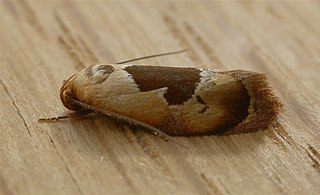Related Research Articles

Prosotas noreia, the white-tipped lineblue, is a species of lycaenid butterfly found in South Asia and Java.

Hoplomorpha camelaea is a moth in the family Oecophoridae first described by Edward Meyrick in 1888. It is found in Australia, where it has been recorded from Victoria, Queensland, New South Wales and the Australian Capital Territory.

Micropardalis doroxena is a species of moth belonging to the family Micropterigidae. It was described by Edward Meyrick in 1888. It is endemic to the North Island of New Zealand.

Pyrgotis plinthoglypta is a species of moth of the family Tortricidae. It is endemic to New Zealand.
Tylostega photias is a moth in the family Crambidae. It was described by Edward Meyrick in 1894. It is found on Borneo.
Catacometes hemiscia is a moth in the family Oecophoridae. It was described by Edward Meyrick in 1883. It is found in Australia, where it has been recorded from New South Wales.
Garrha costimacula is a moth in the family Oecophoridae. It was described by Edward Meyrick in 1883. It is found in Australia, where it has been recorded from Queensland and New South Wales.
Dichomeris uranopis is a moth in the family Gelechiidae. It was described by Edward Meyrick in 1894. It is found in Myanmar.
Doxogenes thoracias is a moth in the family Lecithoceridae. It was described by Edward Meyrick in 1908. It is found in Sri Lanka.
Tisis argyrophaea is a moth in the family Lecithoceridae. It was described by Edward Meyrick in 1910. It is found on Borneo.
Tisis hemixysta is a moth in the family Lecithoceridae. It was described by Edward Meyrick in 1910. It is found on Borneo.
Lecithocera ancylota is a moth in the family Lecithoceridae. It was described by Edward Meyrick in 1894. It is found in Myanmar.
Torodora characteris is a moth in the family Lecithoceridae. It was described by Edward Meyrick in 1894. It is found in Burma.
Catoryctis eugramma is a moth in the family Xyloryctidae. It was described by Edward Meyrick in 1890. It is found in Australia, where it has been recorded from New South Wales and Queensland.
Eclecta is a monotypic moth genus in the family Depressariidae. Its only species, Eclecta aurorella, has been found in the Australian state of New South Wales. Both the genus and species were first described by Edward Meyrick in 1883.
Enchocrates phaedryntis is a moth in the family Depressariidae. It was described by Edward Meyrick in 1888. It is found in Australia, where it has been recorded from Western Australia.
Eutorna caryochroa is a species of moth in the family Depressariidae. It was described by Edward Meyrick in 1889. It is endemic to New Zealand.
Gonionota comastis is a moth in the family Depressariidae. It was described by Edward Meyrick in 1909. It is found in Peru and Colombia.
Imma autodoxa is a moth in the family Immidae. It was described by Edward Meyrick in 1886. It is found on Fiji.

Asaphodes cosmodora is a species of moth in the family Geometridae. This species is endemic to New Zealand.
References
- ↑ Savela, Markku, ed. (December 31, 2014). "Tisis helioclina (Meyrick, 1894)". Lepidoptera and Some Other Life Forms. Retrieved September 12, 2020.
- ↑ Transactions of the Entomological Society of London. 1894 (1): 19.
| This article relating to the subfamily Lecithocerinae is a stub. You can help Wikipedia by expanding it. |